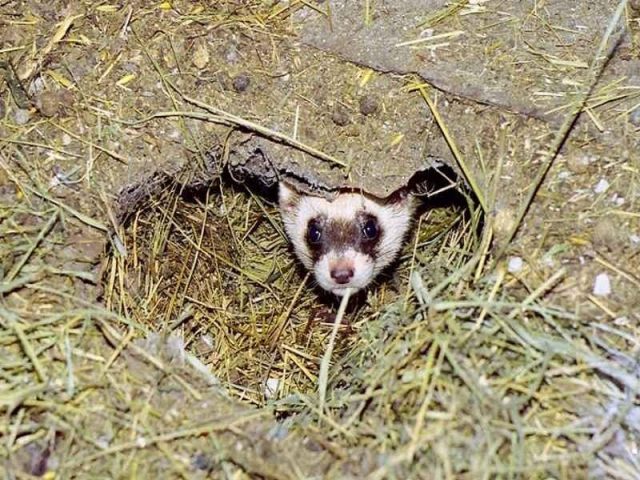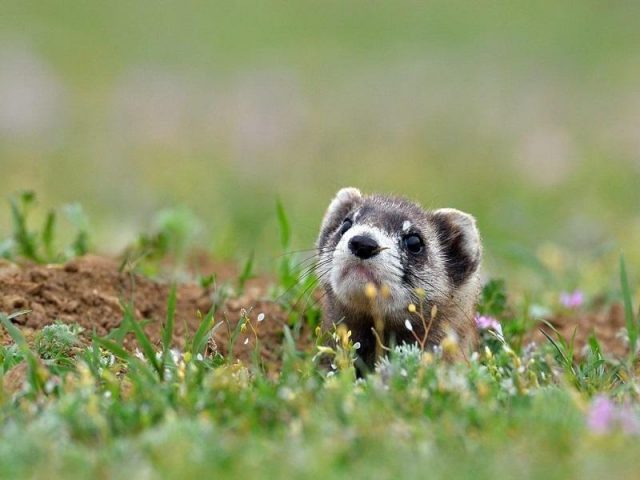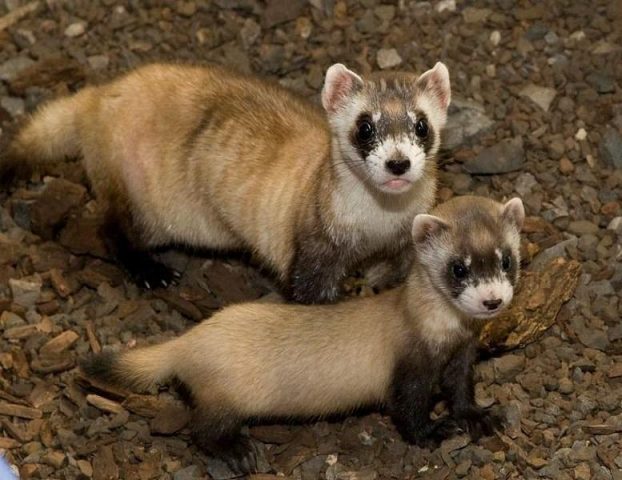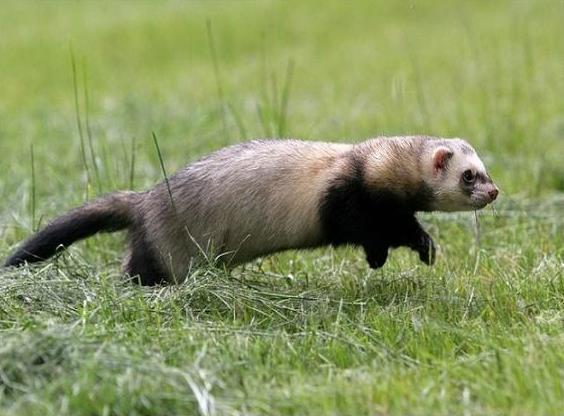Content
The steppe ferret is the largest living in the wild. In total, three species of these predatory animals are known: forest, steppe, black-footed. The animal, together with weasels, minks, ermines, belongs to the weasel family. The ferret is a very agile, nimble animal with its own interesting habits and character traits. Acquaintance with them helps to better understand the causes of behavior, the peculiarities of the life of the species in the wild.
What a steppe ferret looks like
According to the description, the steppe ferret resembles black, but is larger than it. The head color of the animal is white. The animal has a body length of up to 56 cm in males, up to 52 cm in females. The tail is up to a third of the body (about 18 cm). The guard hair of the coat is long, but sparse. Through it, a thick, light-colored undercoat is visible. The color of the coat depends on the place of residence, but the general species features are the same:
- body - light yellow, sandy shade;
- the abdomen is dark yellow;
- chest, paws, groin, tail - black;
- muzzle - with a dark mask;
- chin - brown;
- the mustache is dark;
- the base and top of the tail are fawn;
- above the eyes - white spots.
Unlike males, females have almost white light spots. The head of adults is lighter than at a young age.
The skull of the steppe ferret is heavier than that of the black, strongly flattened behind the eye orbits. The ears of the animal are small, rounded. The eyes are bright, shiny, almost black.
The animal has 30 teeth. Among them are 14 incisors, 12 false-rooted ones.
The body of a representative of the species is squat, thin, flexible, strong. It helps the predator to penetrate any hole, crevice.
Paws - muscular, strong claws. The legs are short and strong. Despite this, steppe ferrets rarely dig holes. To protect against attack, the animal uses the secret of the anal glands with a disgusting odor, which it shoots at the enemy in moments of danger.
The habits and character of steppe ferrets
The steppe ferret leads a twilight lifestyle. Rarely active during the day. For the nest he chooses a hill, occupies the burrows of hamsters, ground squirrels, marmots. The cramped entrance expands, and the main resting chamber remains the same. Only when urgently needed he digs a hole himself. The dwelling is located near rocks, in tall grass, tree hollows, old ruins, under roots.
The ferret swims well, knows how to dive. Climbs trees very rarely. Moves on the ground by jumping (up to 70 cm). Dexterously jumps from great heights, has a keen hearing.
The steppe ferret is a loner. He leads this way of life until the mating season. The animal has its own territory for living and hunting. Although its boundaries are not clearly delineated, fights between individual neighbors are rare. With a large number of animals in one territory, a certain hierarchy is established. But it is not stable.
The steppe ferret flees from a serious enemy. If it is impossible to run, the animal releases a fetid liquid from the glands. The enemy is confused, the animal leaves the pursuit.
Where it lives in the wild
The steppe ferret settles in small forests, groves with glades, meadows, steppes, wastelands, pastures. He does not like large taiga tracts. The hunting place of the animal is the edge of the forest. You can find a predator near water bodies, rivers, lakes. He also lives in the park.
The way of life of the steppe ferret is sedentary, it is tied to one place, to a small territory.For shelter, he uses heaps of dead wood, haystacks, old stumps. It is extremely rare to settle next to a person in sheds, in attics, in a cellar.
Its habitat extends to plains, highlands, mountainous terrain. The steppe ferret can be seen in alpine meadows at an altitude of 3000 m above sea level.
A large population of the predator inhabits the west, center and east of Europe: Bulgaria, Romania, Moldova, Austria, Ukraine, Poland, Czech Republic. The animal is found in Kazakhstan, Mongolia, China. In the United States, the steppe ferret is found on the prairies, east of the Rocky Mountains.
The wide distribution area is explained by several features of the predator:
- the ability to store food for future use;
- the ability to change the diet;
- the ability to repulse enemies;
- the presence of fur that protects against hypothermia and overheating.
Where does the steppe ferret live in Russia
The steppe ferret on the territory of Russia is widespread in the steppes and forest-steppe zone. On the territory of the Rostov region, Crimea, Stavropol, the population size has greatly decreased in recent years. The animal lives in the territory from Transbaikalia to the Far East. It is able to live in the mountains at an altitude of 2600 m. The area of the range in the Altai Territory is 45000 square meters. km.
In the Far East, a subspecies of the steppe ferret, the Amursky, is widespread, the habitat of which is the Zeya, Selemzha, Bureya rivers. The species is on the verge of extinction. Since 1996, it has been listed in the Red Book.
What does the steppe ferret eat?
The steppe ferret is a predator, the basis of its nutrition is animal food. He is indifferent to vegetable.
The diet of the animal is varied, depending on the place of residence at the moment. In the steppes, gophers, jerboas, lizards, field mice, and hamsters become its prey.
The steppe ferret hunts ground squirrels on the ground, sneaking up on them quietly, like a cat, or digging up their holes. First of all, the animal eats the brain of the gopher. He does not eat fat, skin, legs and entrails.
In summer, snakes can become its food. The steppe ferret does not disdain large locusts.
The animal swims great. If the habitat is located near water bodies, then hunting for birds, water voles, frogs, and other amphibians is not excluded.
The steppe ferret loves to bury food in reserve, but often forgets about hiding places, and they remain unclaimed.
The accusations against predators of attacking poultry and small animals are greatly exaggerated. The damage attributed to this predator is often actually inflicted on humans by foxes, weasels, martens.
The volume of food eaten per day by the steppe ferret is 1/3 of its weight.
Breeding features
The mating season for steppe ferrets occurs in late February and early March. Animals reach puberty at the age of one. Before mating, the female seeks shelter for herself. The animals have no desire to dig a hole on their own, more often they kill gophers and occupy their home. Having expanded the passage into the hole to 12 cm, they leave the main chamber in its original form, insulating it with leaves and grass before giving birth.
Unlike forest ferrets, steppe ferrets create persistent pairs. Their mating games look aggressive. The male bites, drags the female by the withers, injuring her.
Females are fertile. After 40 days of gestation, from 7 to 18 blind, deaf, naked and helpless cubs are born. The weight of each is 5 - 10 g. The eyes of the puppies open after a month.
At first, the females do not leave the nest, feeding the cubs with milk. The male at this moment is engaged in hunting and brings prey to his chosen one. Starting at five weeks, the mother starts feeding the puppies with meat. The brood leaves for the first hunt at the age of three months. After training, young people become adults, independent and leave the family in search of their territory.
A couple may have up to 3 broods per season. Sometimes puppies die. In this case, the female is ready to mate in 1 - 3 weeks.
Survival in the wild
In the wild, steppe ferrets do not have many enemies. These include foxes, wolves, wild dogs.Large birds of prey, hawks, falcons, owls, eagles, can hunt animals.
The steppe ferret has good physical characteristics, which allows him to hide from the claws of enemies. The animal is able to knock the fox and other predators off the track if it uses the odorous secretions of the glands. The enemy is confused by this, which gives time to escape.
In the wild, ferrets often die in infancy from diseases and predators. The females' ability to produce several litters per year makes up for losses.
The average life span of a steppe ferret in natural conditions is 4 years.
Man-made landfills and buildings pose a huge danger to animals. He cannot adapt to such conditions and dies, falling into technical pipes, suffocating in them.
Why is the steppe ferret listed in the Red Book?
Experts say that the population of the steppe ferret is constantly decreasing, in some regions the species is on the verge of extinction.
Despite its small number, until recently, the animal was used for industrial purposes for the manufacture of various kinds of clothing. The development of the steppe and forest-steppe by humans leads to the fact that the ferret leaves its usual habitat and moves to places unusual for it. The area of residence is shrinking as a result of deforestation, an increase in the area of arable land.
The animals die from diseases - rabies, plague, scrubingillosis. The number of ferrets is also declining due to a decrease in the population of ground squirrels, the main food of the predator.
The steppe ferret brings great benefits to agriculture, exterminating harmful rodents. In areas where field cultivation is developed, hunting for it has long been prohibited.
As a result of the reduction in the number of individuals, the steppe ferret was included in the International Red Book.
To increase the population, protected areas are being created, bans on the use of traps have been introduced - to prevent even the accidental killing of the steppe ferret. Zoologists are engaged in animal breeding.
Interesting Facts
The habits of the wild steppe ferret and the one living in the house have been studied by people for many centuries. Some facts of his life are interesting:
- the animal makes supplies in large volumes: for example, 30 killed ground squirrels were found in one burrow, and 50 in the other;
- in captivity, the hunting instinct of an animal disappears, which allows it to be kept as a pet;
- steppe ferrets, unlike forest ferrets, keep family ties;
- animals do not show aggression towards their relatives;
- sleep up to 20 hours a day;
- a newly born puppy can fit into the palm of a two-year-old child;
- the predator does not have an innate fear of people;
- black-footed ferret gets along problematic;
- poor eyesight of the animal is compensated by the sense of smell and hearing;
- the normal heart rate of a predator is 250 beats per minute;
- the ferret serves as a mascot for American sailors.
Conclusion
The steppe ferret is not just a funny fluffy animal. He has been living next to a man for a long time. In Medieval Europe, he replaced cats, today the animal helps to protect the fields from the raids of harmful rodents. The size of its population is declining everywhere, and therefore it is necessary to continue to take measures to restore the species in its natural habitats.













